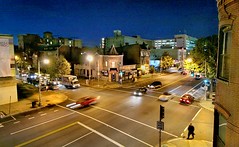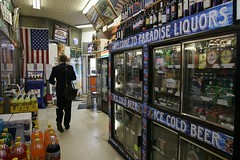Community Preservation and Gentrification
Because I was away and because I didn't think the articles say very much, I haven't commented on the two-part story in the Post from Sunday and Monday about the changes at 14th and T. (See "One Urban Panorama Fades, Another Rises" and "A Boom Giveth, and It Taketh Away.")
 Washington Post photo by Michael Williamson. (A panorama view is available online.)
Washington Post photo by Michael Williamson. (A panorama view is available online.)However, someone with whom I correspond asked me what I thought, and since we have had a number of good e-conversations over the past year from which I have learned a lot, I felt obligated to reply:
I could give an #$%^&* about the displacement of liquor stores that contribute to disorder and urban churches that contribute little to the surrounding neighborhood. Said institutions have been around a long time and likely helped "produce" the negative conditions--to use the word in the sense of Marxist sociologists looking at these issues from the other side.
As you might have guessed from some of my postings, I have long ago succumbed to compassion fatigue. And while I do ascribe some of the problems to "learned helplessness" and what I call "governmentalizing" problems and responses, I still think that at least some of the problems in neighborhoods have been caused or at least abetted by the people in them.
OTOH, I appreciate the points made by Logan and Molotch about the "use value of place" and that some of my beliefs on this are colored by my own standing, value set, etc.
2. At the same time, displacement and the constant escalation of housing prices is not a "good thing." It's complicated by the fact (at least imo) that people of color have a behavioral lag in terms of appreciating urban living and many people in this demographic are continuing to migrate to the suburbs in search of the American dream.
Thus far, (in DC) we haven't done a very good job in providing for a diversity of housing types and rental support programs to help maintain housing available to people across the spectrum of SES, in particular those of lower-incomes. E.g., if we have SRO housing within 2 miles in diameter of downtown it's news to me. Meanwhile, Portland OR has such right on the border of two upscale neighborhoods, a short walk from PGE Park and the Light Rail stop.
For a different approach, see this article from Shelterforce: "Gentrification and Resistance in New York City " by Kathe Newman and Elvin Wyly. The abstract: Three recent studies imply that gentrification does not cause displacement. Not so, contend our authors, and they show what it takes to help people stay when the community improves.
3. Yesterday's Post (and I have been away for the last couple days so I am just now working through the papers I missed) has an important article about the escalation of housing prices across the city, and that to buy a house at these prices people need incomes of at least $75,000. See: "Most D.C. Property Priced Out Of Reach: Median Earner Can't Buy Vast Majority of Homes, Researchers Conclude." Click here for the full report, Housing in the Nation's Capital, and here for a transcript of an interview with the Fannie Mae Foundation president--FMF commissioned the report.
4. Housing prices are starting to stabilize and demand is dropping a little. I don't know if we'll run into a housing recession or not. We did in late 1989, and it lasted until 1999. It was brutal. This time the market is even hotter. Granted that there are more higher income people, but I don't think the supply of higher income urbanites is unlimited... Just on a couple streets in my neighborhood there are about 2,000-2,500 units in process.
5. Some of this makes me sick.... Living through it is something else. I moved into the city at a time when people with suburban sensibilities didn't want to live here. Again in the argot of sociology, new residents are now "producing" different experiences from those typically urban.
 Washington Post Photo by Michael Williamson. (L) Meghan Ely (age 25) and Ronda McCarthy (age 22) enjoy an after work brew at Cafe Saint-Ex at 14th and T Sts.
Washington Post Photo by Michael Williamson. (L) Meghan Ely (age 25) and Ronda McCarthy (age 22) enjoy an after work brew at Cafe Saint-Ex at 14th and T Sts.From the second email:
Re your point that "Several of the West Coast cities intervened pretty actively to save at least a portion of the residential hotel stock and bring it under stable management, I don’t know if that’s happened in Washington."
Not in the least. And where the city could have made a real difference was in being very purposive in how city-owned land is used for housing projects. Instead of making sure a big chunk of such land is used to provide a wider variety of housing options available to those with fewer resources, most projects have gone to the highest bidder for market-rate housing. At this juncture, very few apartment projects are being built, it's all condos. Of course, who can afford $3,000/mo. apartment units?
The City has launched a "New Communities" program, basically a local HOPEVI program. But I have some reservations. The first proposed project has outlandish subsidies when you figure it out by the numbers, in effect more than $1 million/unit of lower-income housing. See these articles from the Post: "Mayor Plans $558 Million For Affordable Housing" from yesterday and this article from today, "Sursum Deal Leaves Some Leery."
 Washington Post graphic.
Washington Post graphic.About the liquor store, I just can't get worked up about its displacement (despite the points in Logan and Molotch) because of the way such stores contribute to disorder in substantive ways. I have quoted this research in various testimonies in the past:
 Paradise Liquors, now closed. PHOTOGRAPHER: NIKKI KAHN/THE WASHINGTON POST.
Paradise Liquors, now closed. PHOTOGRAPHER: NIKKI KAHN/THE WASHINGTON POST. Spatial Dynamics of Alcohol Availability, Neighborhood Structure and Violent Crime DM Gorman, PW Speer, PJ Gruenewald, EW Labouvie - Journal of Studies on Alcohol, 2001 - ncbi.nlm.nih.gov OBJECTIVE: This study examined the relationship between neighborhood social structure, alcohol outlet densities and violent crime in Camden, New Jersey.
His response:
I get about 1,200 net new units in that project for the $558 million, so about $500,000 per. Still an awful lot of money, even if some of it would be private. I have to wonder if it wouldn’t make more sense just to rehab the existing units and add density somewhere else. From a distance what the Councilmember is saying makes sense, to keep the existing residents in place you have to bring an awful lot of subsidy from multiple sources (and if it’s a coop, what’s their equity worth?).
The only good thing about a housing bust would be that it might allow some moderate income people to get into the market. Of course in California there’s really no sign of a bust, despite continuous articles about how the market is “slowing down.”
____________________
Interestingly enough, in the housing field, which I am not really active in, there is what you would call a movement for "Community Preservation." This focuses on the continued provision of lower-income housing. For me, when I see the word "preservation" I usually think buildings not people.
This is important work. One of the more interesting proponents of "Community Preservation" is the activist community development corporation, St. Nicholas Neighborhood Preservation Corporation, in Brooklyn. The leading proponent of this approach in Washington is the Community Preservation and Development Corporation. One of their successes is the Edgewood Terrace complex near the Rhode Island Metro station.



0 Comments:
Post a Comment
<< Home